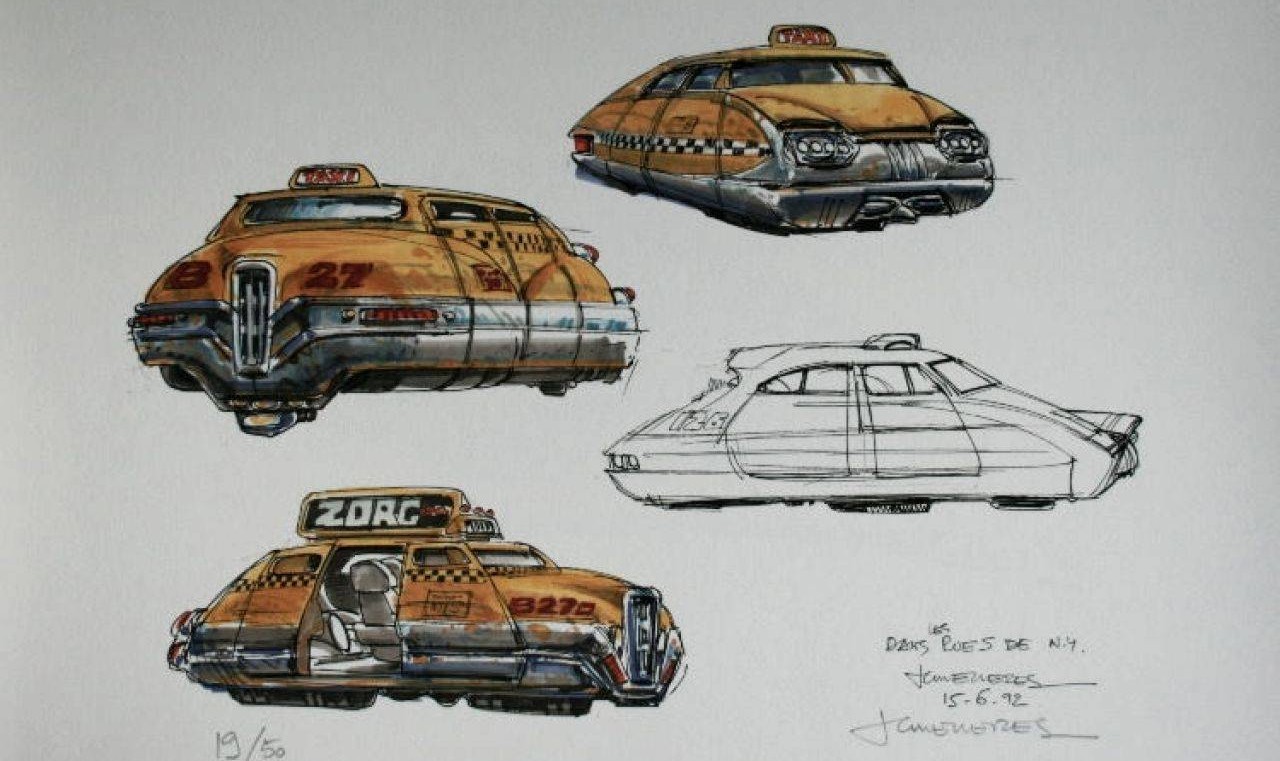
(Jean-Claude Mézières)
Translation provided by ChatGPT, link to the original article in Russian
Link to Part 1: «Preliminary Analysis» (ру / eng )
Link to Part 2: «Experiments on a Torus» (ру / eng )
Link to Part 3: «Practically Significant Solutions» (ру / eng )
Link to «Summary» (ру / eng )
1. About this series of articles
1.1 Central result
If I haven't made a critical mistake, I have discovered an astonishing passenger transportation scheme with unique characteristics. Imagine this scenario: you are in a big city and need to get from point A to point B. All you need to do is walk to the nearest intersection and indicate the destination on your smartphone or a special terminal installed there. In a few minutes, a small but spacious bus will arrive for you. The bus is designed for easy entry without bending, and you can bring a stroller, bicycle, or even a cello inside. It provides comfortable seating where you can stretch your legs. This bus will take you to the nearest intersection to point B, and you will reach your destination without any transfers. The entire journey, including waiting at the stop, will take only 25-50% more time than if you were traveling by private car. Based on my estimation, in modern metropolises, this type of transportation will be widely adopted, and the cost of a trip on such buses will be similar to the fare of a regular city bus.
Surprisingly, the reasoning behind these findings is based on relatively simple mathematics, and perhaps even a talented high school student, under fortunate circumstances, could have guessed them on their own. The practical significance of the topic and the modest level of mathematical requirements prompted me to make an effort to write the article in such a way that the reader could follow the path of discoveries, learn some research techniques, and gain a successful example to explain to their children the purpose of mathematics and how it can be applied in everyday life.
1.2 Initial Problem
The story of how I embarked on this research and discovered its most valuable result is quite amusing. Allow me to briefly tell you about it. This article is not my first work in the field of urban transportation issues; I have already published two or three articles (№1, №2), depending on how you count them. Sometimes, students and various entrepreneurs reach out to me regarding their topics. About six months ago, I received a call from a very ambitious young man. He asked if I could help him come up with a way to make it easier and more convenient for ordinary (and not so ordinary) people to commute to and from work. His initial idea was to transport workers using something like a school bus and create a new, more convenient form of public transportation based on that concept. As you can imagine, the idea was quite grandiose and enticing. However, at that time, I was working on my book and wanted to avoid getting too involved in another task. Nevertheless, I couldn't completely refuse, so I offered to help this young man formalize his problem and find those who would be capable of solving it. However, as is often the case with entrepreneurs (and I don't blame them at all—I've been there myself), the author of this wonderful idea disappeared from our communication. Yes… perhaps the author vanished, but at that point, his idea had already captured my thoughts, and I set aside all other matters to study it.
Quite quickly, I found a decent solution — shared taxis with one transfer, which is the subject of one of the chapters of this work. At that time, I was almost certain that there was no better solution to the problem and tried to prove it rigorously. However, I couldn't seem to come up with a proof. In the end, I had to question the hypothesis of «impossibility» and attempted to construct a hypothetical «counterexample» for it. To my surprise, such a counterexample actually emerged.
In this series, I plan to publish 3 articles: the current one — «Preliminary Analysis,» the next one — «Experiments on the Torus,» and the final one — «Practically Significant Solutions.» Their content is more of a journal documenting the steps of its directed search rather than describing a specific result. By choosing this narrative approach, I wanted each subsequent step to be almost evident to the reader, while the final result wouldn't seem astonishing.
Reading the article will take some time. If the formulas are not displayed correctly, try reloading the page several times.
2. City Model and Model of Intraurban Daily Migration
2.1 Idealization as a Research Method
In this article, we will focus only on the problems of various types of public transport that arise due to physical or mathematical constraints and therefore cannot be eliminated in principle. Problems that can be overcome due to engineering errors, imperfections in public infrastructure, lack of knowledge, or oversight will be left to specialists in other fields. The best way to see which problems are insurmountable for a particular scheme of passenger transportation is to observe its operation in the conditions of an ideal imaginary city. If a certain type of public transport exhibits drawbacks in idealized conditions, it is evident that they will persist in real-world conditions.
2.2 Ideal Grid City
Let's suppose you are tasked with designing a new city with a convenient transportation system. You wouldn't go wrong if you choose a grid layout for it, commonly known as the Manhattan grid. In an ideal Manhattan grid layout, the streets form a regular orthogonal network, dividing the city into uniformly shaped and sized blocks. In one of my previous works, I demonstrated that in cities with a Manhattan grid layout, all street traffic can be coordinated into green waves (link). When a city operates under this regime, any driver who maintains the recommended speed and moves only forward can reach the end of a street, stopping at traffic lights at most once. In another one of my works, you will find arguments that among all encountered layouts, the grid layout contributes the least to traffic congestion. These observations should explain to the reader why I consider grid cities as the idealized model in this context.
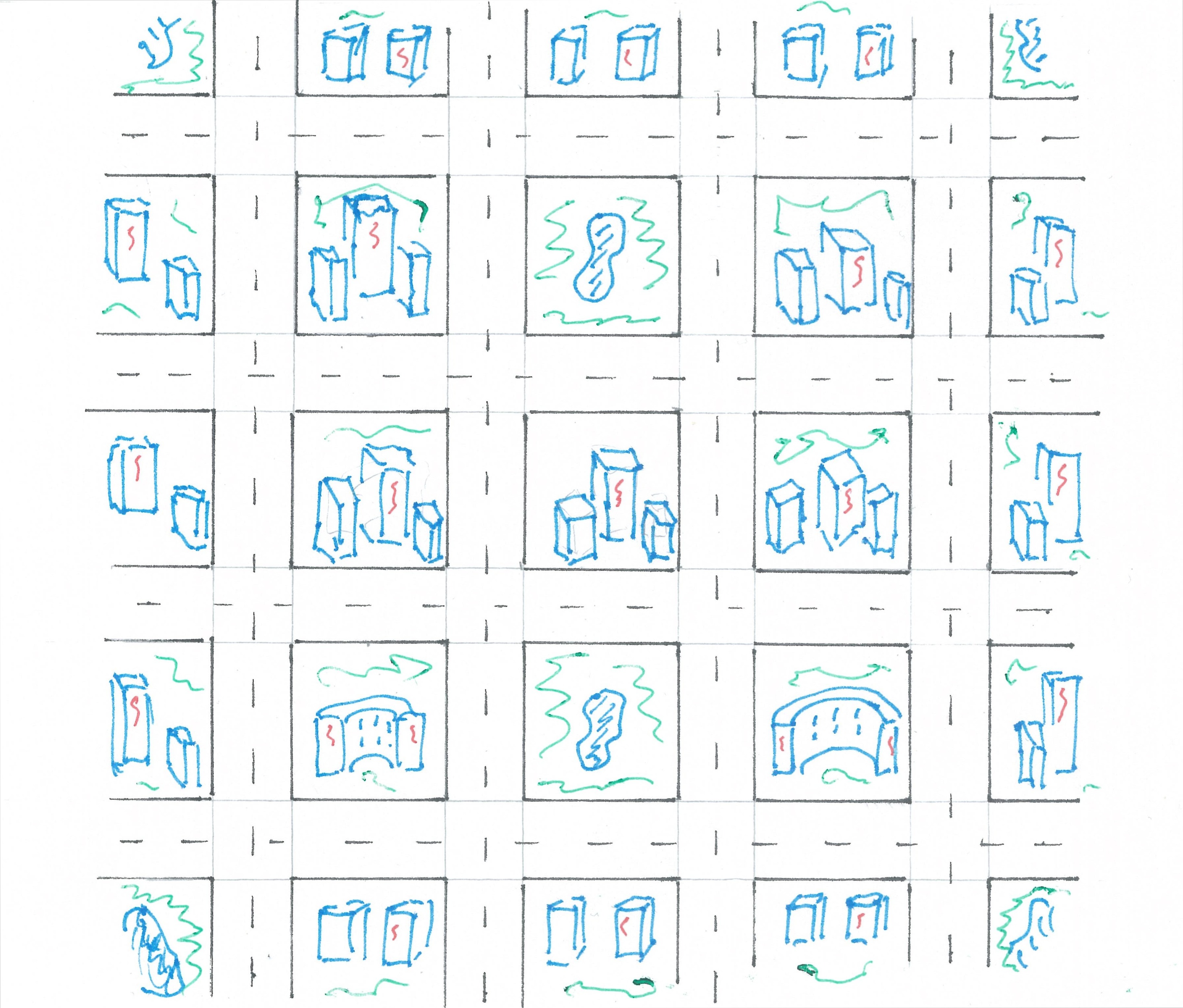
Our main model will be a rectangular grid city with square half-kilometer blocks and two-way traffic. The choice of half-kilometer block length is not arbitrary — smaller lengths make it difficult to organize green waves, while larger lengths result in excessively long distances that need to be covered on foot. An alternative model is a grid city with alternating one-way traffic and square blocks measuring 250 meters. This model will mainly be used in exercises. In terms of optimality, both models are essentially equivalent to each other. In the final chapters, the size and aspect ratio of the blocks are insignificant, as long as the blocks are not excessively large.
Another simplification I will soon employ is folding the flat rectangular city into a torus. The thing is, a rectangle has edges, which makes the positions of points on it non-equivalent: some points are closer to the center, while others are closer to the periphery. This non-uniformity introduces qualifications into the reasoning and makes the calculations unnecessarily technically complex. A torus, on the other hand, has no edges, and all its points are in completely equal conditions. Just like on a sphere, by using a suitable «rotation,» any point on the torus can be mapped (translated) to any other point. Public transportation in a toroidal grid city encounters the same problems as public transportation in a regular «flat» city, except for the special behavior at the edges. What's more important, these problems have similar solutions in both cases. For readers unfamiliar with the concept of a (flat) torus, I have included two introductory chapters in the article.
2.3 Migration Model. City with Random Access
A detailed analysis of urban passenger transportation is hardly possible without knowing how, where, and how often the residents of the city make their trips. In this article, we will adhere to the following simplest assumptions:
1) Within the same time frame, approximately the same number of people in any given block have the desire to travel to another point in the city.
2) For a randomly selected trip, regardless of its starting point, any other point in the city is equally likely to be the destination (the probability of a point being the end of the trip is uniformly distributed throughout the city).
We will refer to this migration model as the «city with random access.»
Undoubtedly, our migration model is purely academic, and the results obtained based on it are estimations. In a real city, human migration may be subject to entirely different laws. Therefore, the implementation of any of the described transportation schemes should be preceded by careful field measurements, and the scheme itself should be appropriately adapted to the results of these measurements.
3. Inherent Limitations of Some Traditional Forms of Public Transportation
Before attempting to create new forms of public transportation, let's try to understand the advantages and disadvantages of existing ones.
3.1 Basic City Bus
By a basic bus, we mean not only regular city buses but also other forms of transportation such as trolleybuses or trams. These are the most conservative types of mass transportation, and their operation follows the same principle: a certain number of vehicles with sufficiently spacious interiors move along predetermined routes, picking up or dropping off passengers at each stop.
Let's consider a city with rectangular blocks of half a kilometer and two-way traffic. The obvious way to create a network of routes for a basic bus in such a city is to assign a separate route for each street, so that buses travel in both directions from one end to the other at intervals of a few minutes. As for the stops, it is most reasonable to locate them at intersections: one for each of the four directions. This arrangement of stops facilitates quick transfers from one direction to another. The described transportation network, in the narrow sense, is what we will refer to as a basic bus system.
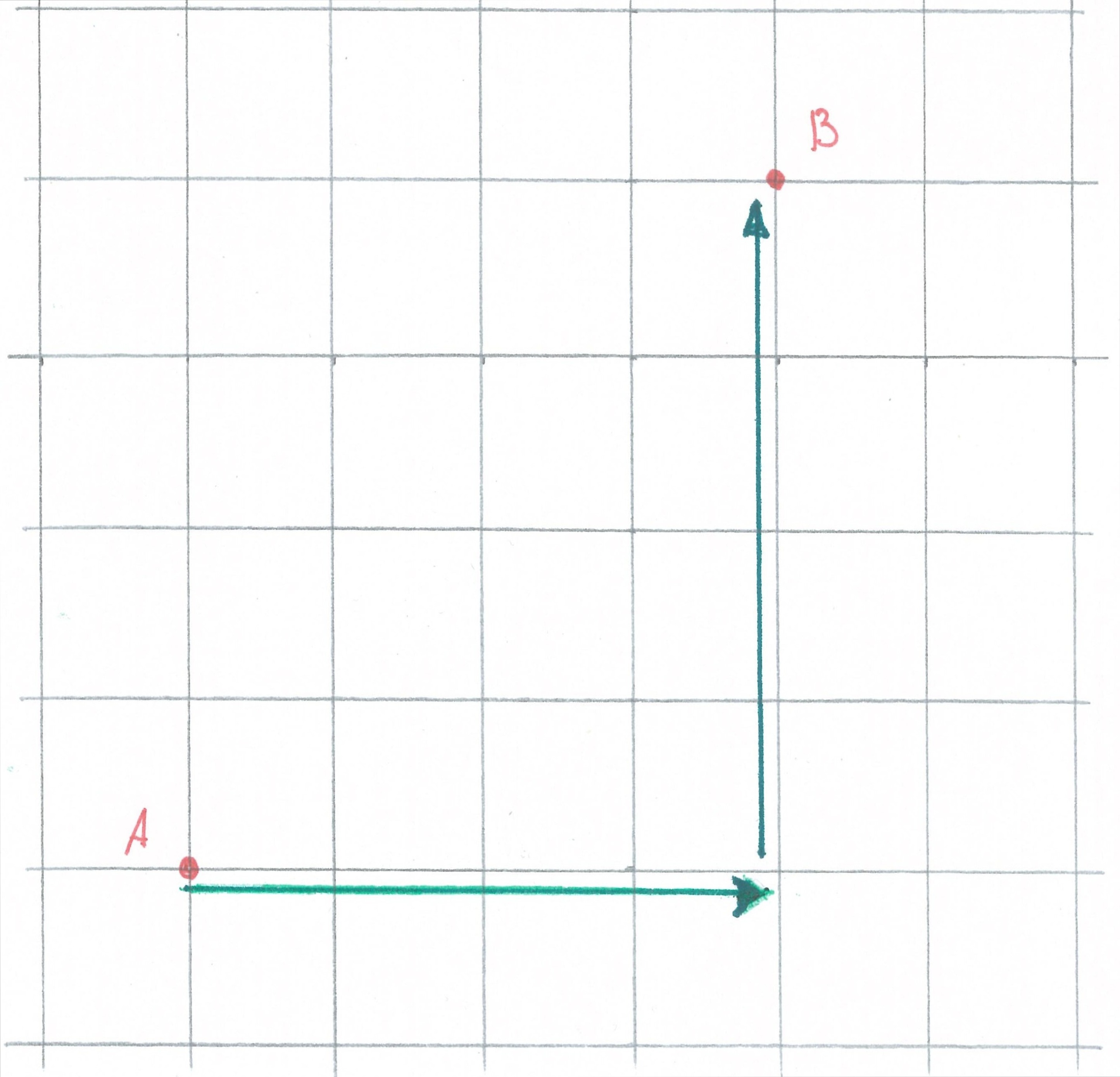
Figure 2
The basic bus as a mode of transportation has several pleasant characteristics:
1) Simple route planning logic.
2) It is possible to reach any other stop from any given stop with just one transfer.
3) If you are already on a street, the stop in any direction is located no farther than half the length of a block.
4) Observations in small-sized cities with low population density show that the average number of passengers on basic buses is sufficient to make the trip relatively inexpensive.
However, despite these advantages, the basic bus has one significant drawback: it is, in theory, very slow and seemingly impossible to improve. The following reasoning explains why.
Let's assume that the maximum allowed speed in the city is 60 kilometers per hour (or 17 meters per second, or 1 kilometer per minute). When departing from the previous stop, the bus cannot instantly reach its maximum speed, and similarly, it cannot instantly come to a stop before the next stop. In both cases, it will take some time for the bus to accelerate or decelerate. Thus, the bus's journey between adjacent stops can be divided into three segments: the acceleration segment, the deceleration segment, and the middle segment, which the bus travels at a constant maximum allowed speed.
According to Google, a comfortable acceleration for passengers is when the bus increases or decreases its speed by 0.7 to 1 meter per second in one second. For calculations, let's assume that the bus's acceleration on the acceleration and deceleration segments is constant and equal to 1 meter per second per second. With these parameters, the bus will require 17 seconds to reach its full speed and another 17 seconds to come to a complete stop. The constant acceleration during acceleration and deceleration means that the speed-time graphs during these periods will be inclined straight lines. By calculating the area under these graphs, we find that the acceleration segment and deceleration segment have a length of 144.5 meters, occurring at the 289-meter mark. We assumed that the distance between adjacent stops is equal to the length of a block, which is 500 meters. Therefore, the middle segment, where the bus travels at its maximum speed, has a length of 211 meters and will be covered in approximately 12 seconds. As a result, the entire half-kilometer journey from stop to stop will be completed by the bus in the best case scenario in 17 + 17 + 12 = 46 seconds. Even if the simple bus does not have any delays at the stops themselves, its average speed would not exceed 500/46 ≈ 11 meters per second.
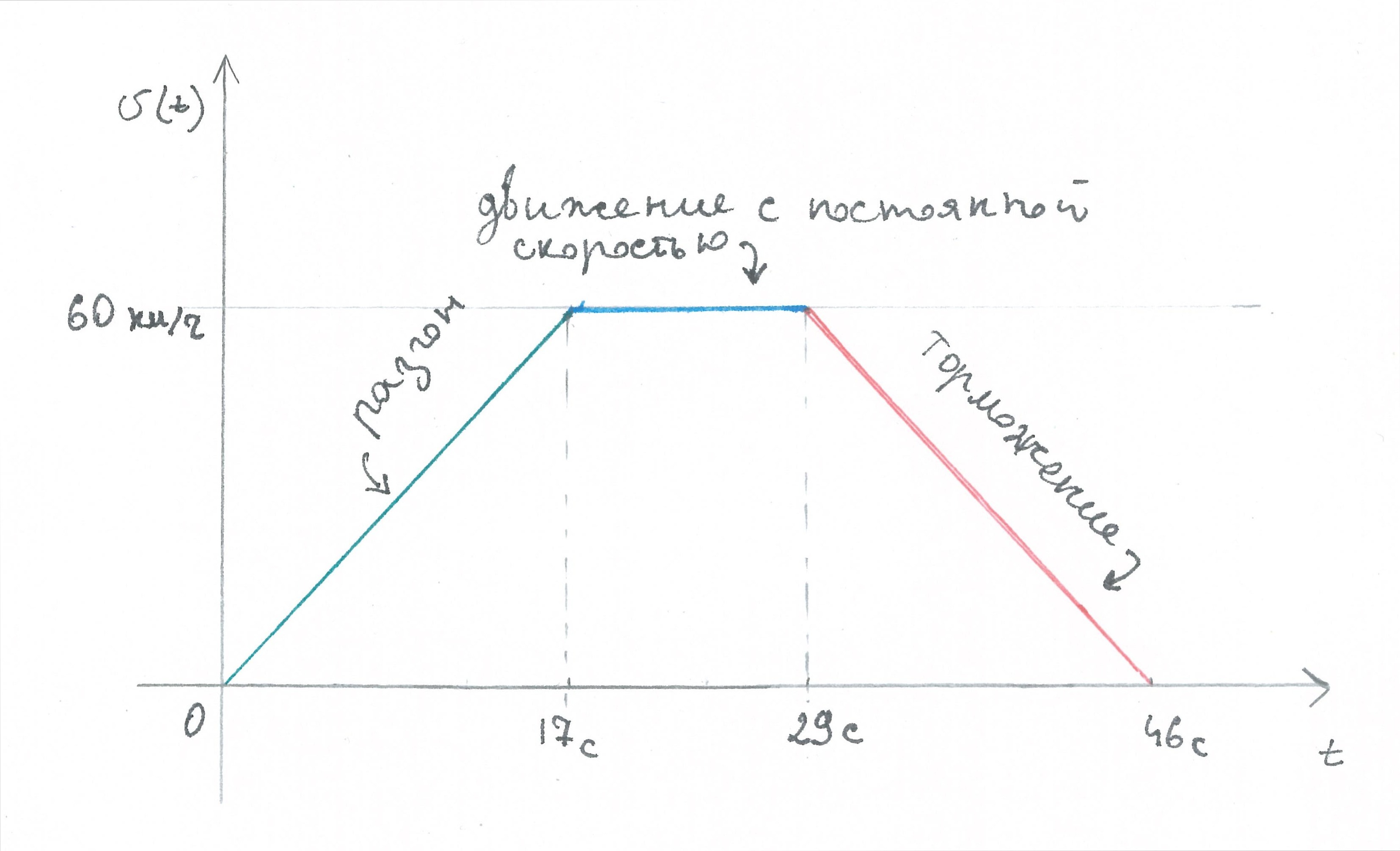
Figure 3
Now let's estimate the average speed of a bus taking into account the duration of its stops. Various sources state that the average time for boarding or alighting a passenger is within the range of
Exercise: If you have read the article about green waves, show that the operation of buses can be integrated into the green wave schedule, allowing them to pass through all intersections without any waiting. However, this is only possible if the average speed of the buses is evenly divisible by the speed of propagation of the green waves.
3.2 Bus Network Including Local and Transit Routes
Can city buses be made faster? To answer this question, let's break down the travel time of a bus between two sufficiently distant points, denoted as

Figure 4
As seen in the above Figure 4, this travel time can be represented as the sum of three components:
In these notations, the average speed of the bus on the segment
If we want
We have no control over the component
The second component
The third term,
Let's assume that on the segment
And so, if we want to increase the average speed of buses on route
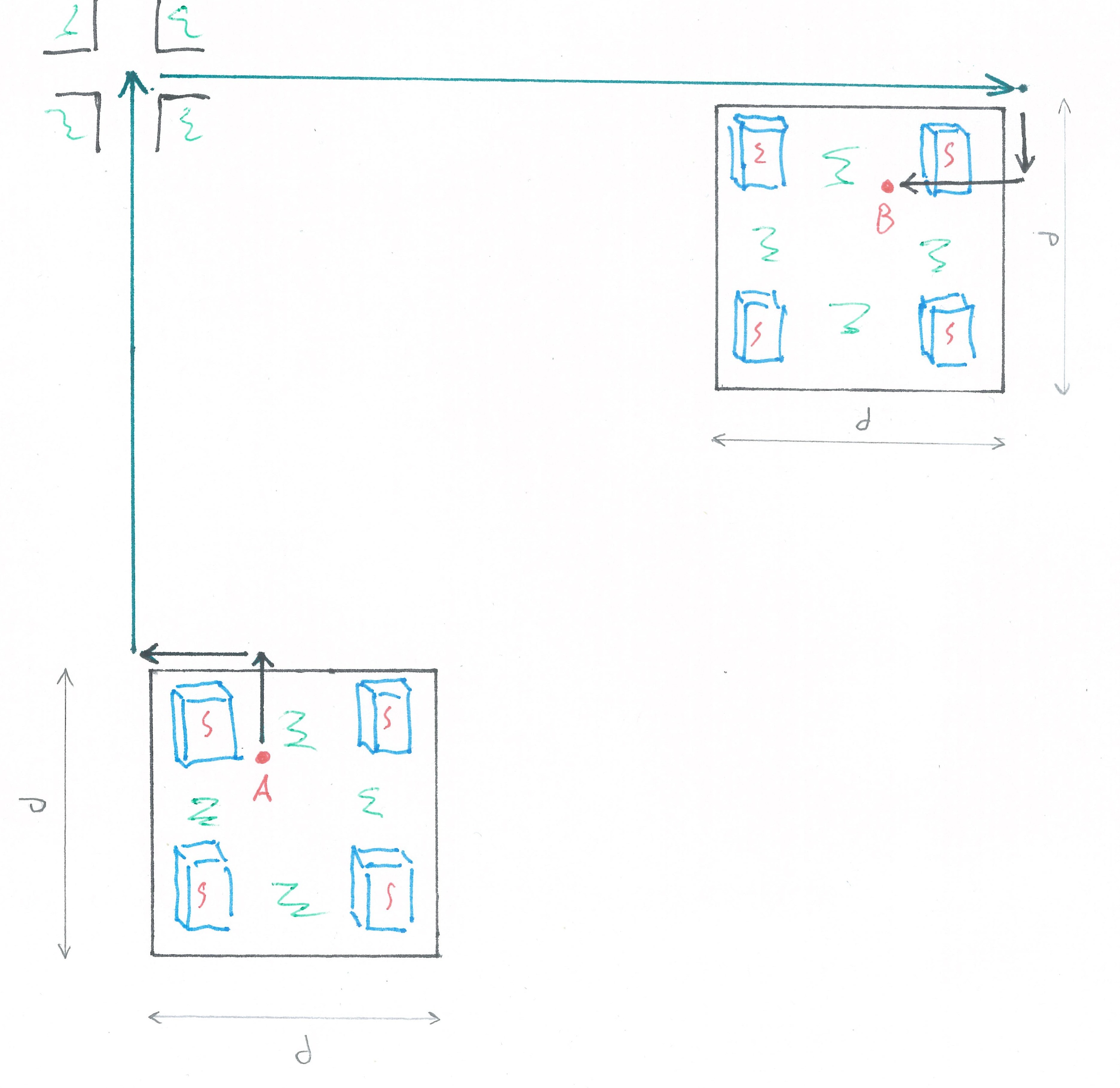
Figure 5
The problem of increasing fares with decreasing bus intervals seems to be unsolvable, but there is a rather obvious and simple solution for the problem of sparsely spaced stops. The solution is to have two duplicate bus routes on each street: one with closely spaced stops, resulting in a «slower» route, and another with stops located at greater distances from each other, making it potentially «faster.» We will refer to the slow routes and the buses operating on them as local, and the fast ones as transit. Naturally, it is necessary to ensure that the stops for local buses are placed at every intersection along their route, while the transit buses only stop at every

Figure 6
The problem of increasing fares with decreasing bus intervals seems to be unsolvable, but there is a rather obvious and simple solution for the problem of sparsely spaced stops. The solution is to have two duplicate bus routes on each street: one with closely spaced stops, resulting in a «slower» route, and another with stops located at greater distances from each other, making it potentially «faster.» We will refer to the slow routes and the buses operating on them as local, and the fast ones as transit. Naturally, it is necessary to ensure that the stops for local buses are placed at every intersection along their route, while the transit buses only stop at every

Figure 6
Let's consider the scenario where the city has both local and transit bus routes, as shown in the above diagram. Now let's think about the actions a traveler should take to reach a destination point
If both points are located on the same street and do not occupy any particular position, a relatively fast way to travel from
First, you need to walk from point
This travel algorithm can be summarized as «L -> T -> L,» where «L» represents the local bus and «T» represents the transit bus.
Exercise: Is the algorithm described above the fastest in terms of average travel time between random points A and B? If not, how should it be modified to become the fastest? What information about the traveler and buses does your solution use?
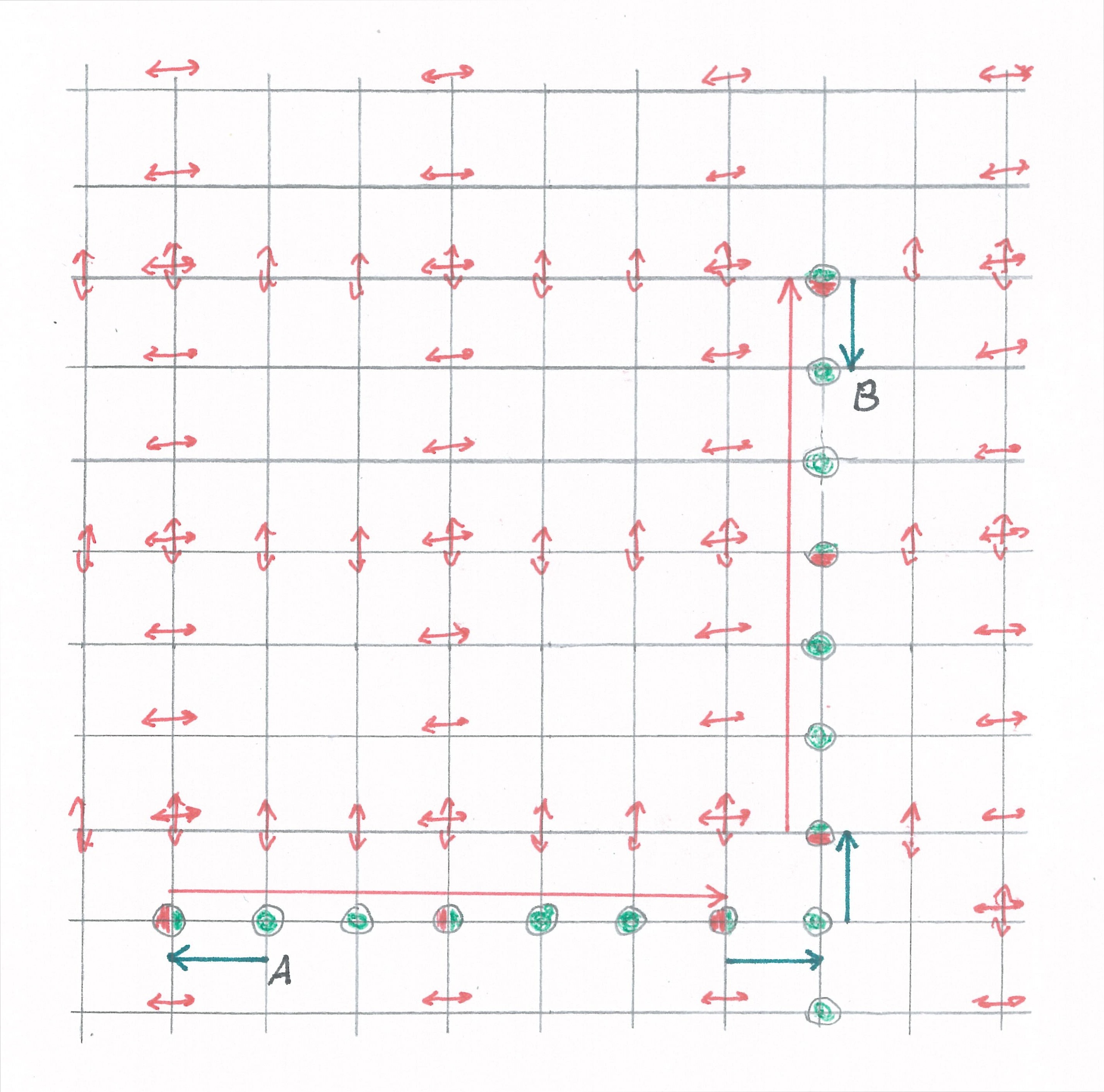
Figure 7
In the general case, when points
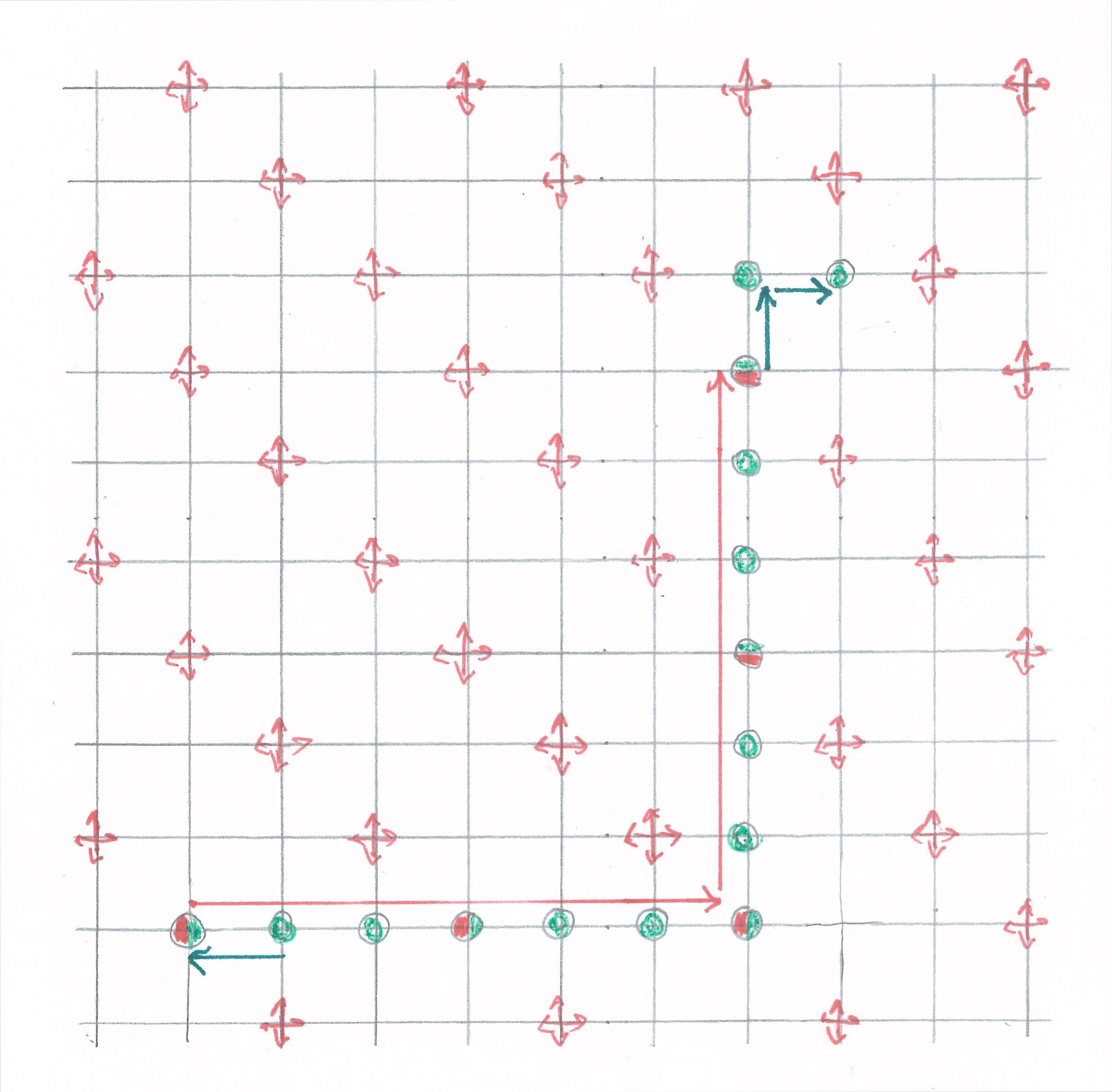
Figure 8
Any bus route network constructed according to the pattern shown in Figure 8 will be referred to as a "local-transit bus network."
Exercise: Find all possible travel scenarios on a local-transit bus network between points of general (non-specific) positioning. Try to describe and classify all special cases, such as travel along a single street or from a point near a transit bus stop.
Let's make a rough estimate of what value
On the stretch between adjacent transit bus stops, the bus undergoes one acceleration and one deceleration. As calculated earlier, the total time lost during these stretches is approximately
The average speed of the transit bus will be close to its maximum only if:
Therefore, we can use the approximation:
and rewrite
The last formula shows that there is no point in trying to make the passenger boarding/alighting time
If, for example, we want transit buses to travel at an average speed of at least
According to my rough estimates, in cities larger than
Exercise: Consider the possibility of using underground metro systems instead of transit buses for the same purpose. What advantages and disadvantages are associated with the solutions you have discovered? Try to make numerical evaluations.
3.3 Personal Taxis
Fast, often very convenient, but also very expensive. Takes up a lot of space on the road and emits a significant amount of exhaust gases per passenger-kilometer.
4. Taxis for Shared Trips between City Districts
4.1 Shared Trip Concept
Personal taxis are perhaps the fastest mode of urban transportation, but undoubtedly the most expensive. In many cases, there is only one passenger being transported in a whole car with a hired driver. Hence, the idea of making taxi trips cheaper becomes evident: it is enough to come up with a method that allows a taxi to carry multiple passengers at once. If such a method is found and implemented, the cost of each kilometer traveled by a taxi can be divided among all the passengers who were in the vehicle at that time. The more passengers on average in the vehicle, the cheaper the trip should be for each of them.
However, the concept of shared trips faces an obvious obstacle: if a shared taxi picks up every person who signals it on the road, there may be passengers in the vehicle who are not heading in the same direction. To transport such passengers to their respective destinations, the taxi would have to travel from one end of the city to the other, wasting its working time and the time of its clients.

Figure 9
One obvious way to address the issue of mismatched fellow travelers is to always try to fill the taxi with passengers whose pickup and drop-off points are close to each other. Below, one of the shared taxi schemes that implements this idea is discussed in detail.
4.2 Operational Guidelines
Let's consider a grid-based city of size
When dealing with personal taxis or private transportation, each trip from one intersection to another can be made along the shortest zigzag route at an average speed close to the maximum allowed in the city. However, enabling a shared taxi to transport multiple passengers simultaneously generally requires lengthening and complicating the route within the starting and ending squares. Of course, there are situations where a shared trip is nearly as fast as a personal taxi ride. For example, if the pickup points for a group of fellow travelers are all located along one street, and the drop-off points are also along another street (possibly a different one), the shared trip route can be planned so that each passenger is delivered to their destination via the shortest route for themselves.
However, the situation just described is more of an exception than the rule. In general, the pickup and drop-off locations of passengers traveling together will be randomly scattered within the starting and ending squares. To gather them first and then disperse them, the taxi vehicle will have to follow a winding route, reduce speed at turns, and cover extra miles. Due to all these factors, the journey in a shared taxi will obviously take, on average, longer than the same trip in a personal taxi. Figure 10 illustrates a fairly typical situation where even two passengers cannot be jointly transported without increasing the travel distance, at least for one of them. Let's try to estimate how much slower, on average, the inter-cell shared taxi is compared to a personal or private car.
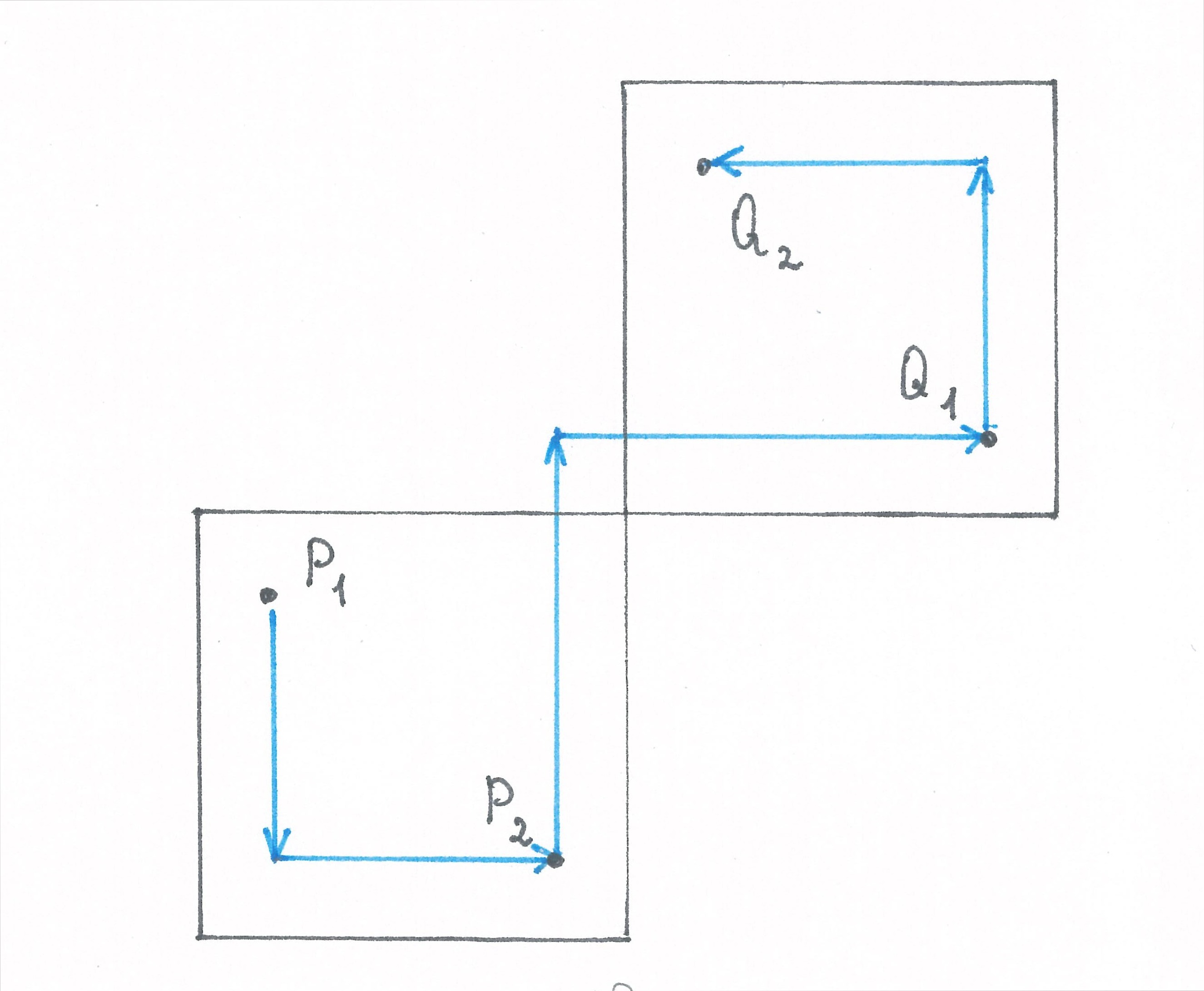
Figure 10
Lemma on routes of intercellular taxi:
Let's assume that there are n travelers who need to be picked up at the «start» square
1) Route
2) Route
3) When using route
4) The entire route
5) If squares
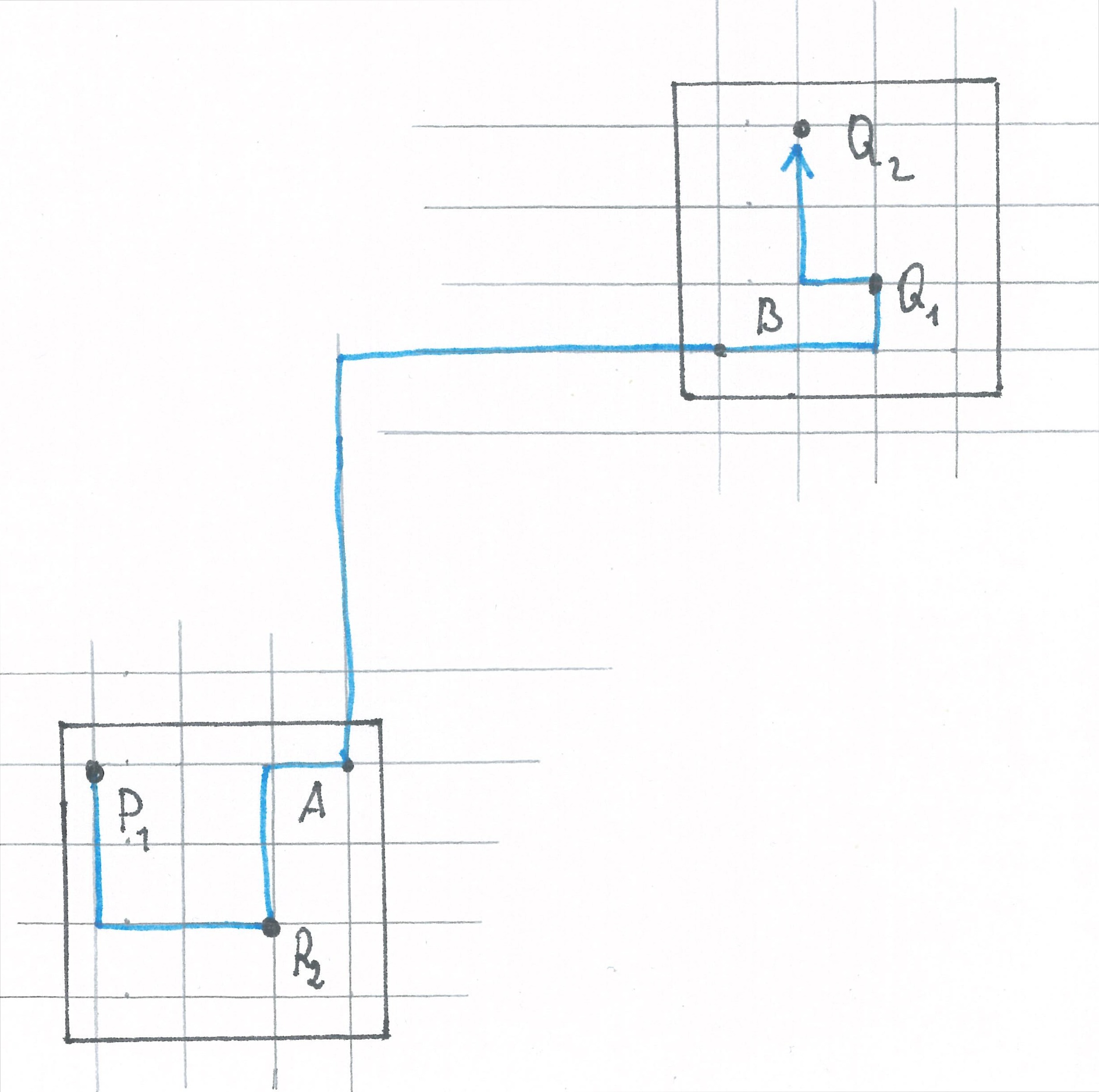
Figure 11
Proof.
The idea of proving 1)-4) is to replace each segment
4.3 Traversal Algorithm
Let
Now, let's imagine that at the specified point
To simplify calculations and reasoning, let's assume that the length
Let's start with an estimation of the asymptotics. Suppose the number of passengers $n$ is a perfect square. We arrange these individuals in the positions of nodes of a regular square grid with a cell size of
Now let's construct a solution for the general case where the initial positions of the
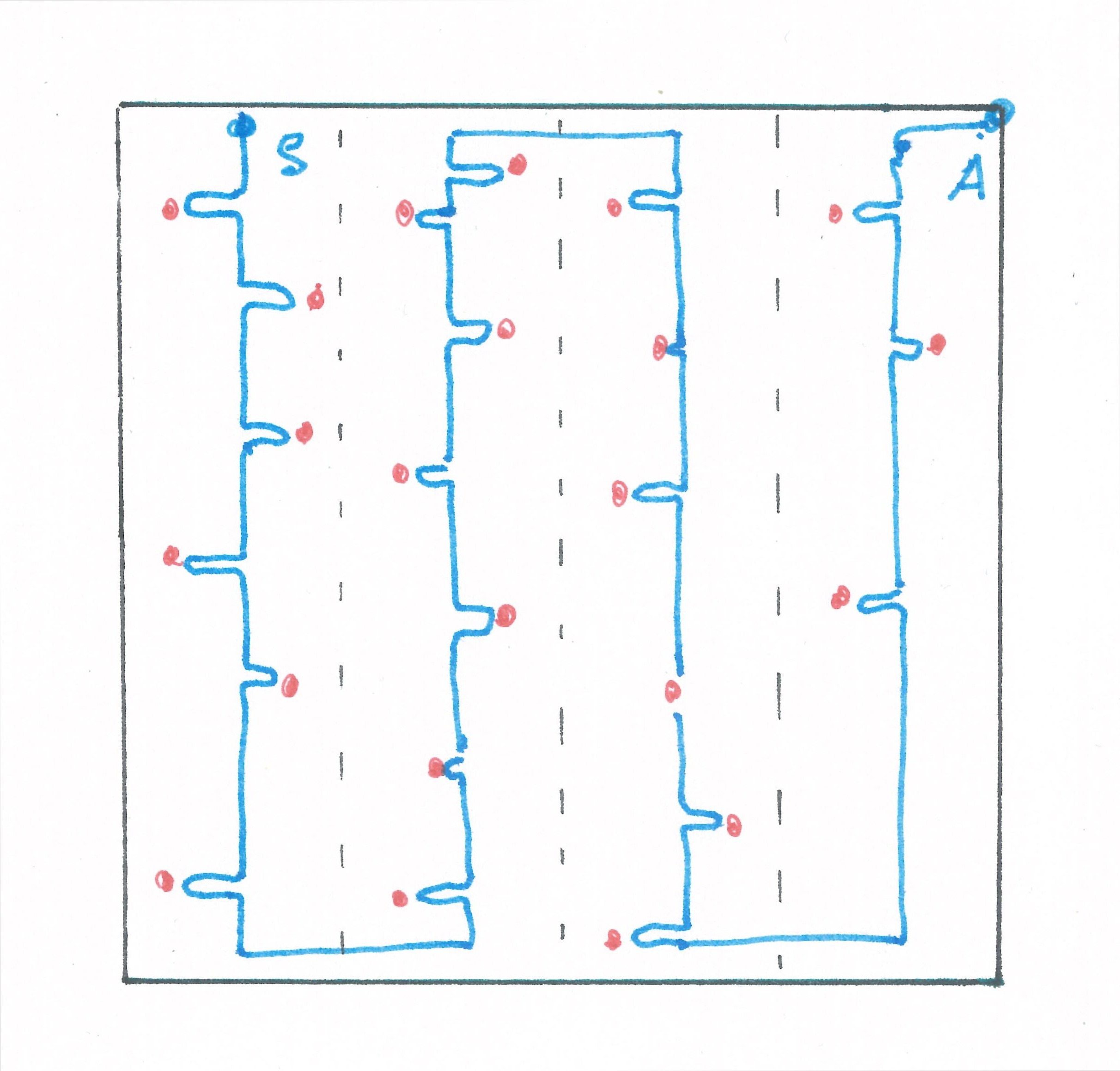
Figure 13
Let's consider that the cell
4.4 Average Length of the Shortest Staircase Path between Two Random Points in a Rectangle
Let's consider a rectangle
The first question is to determine which staircase curves from
To answer the first question, we will consider every staircase path from
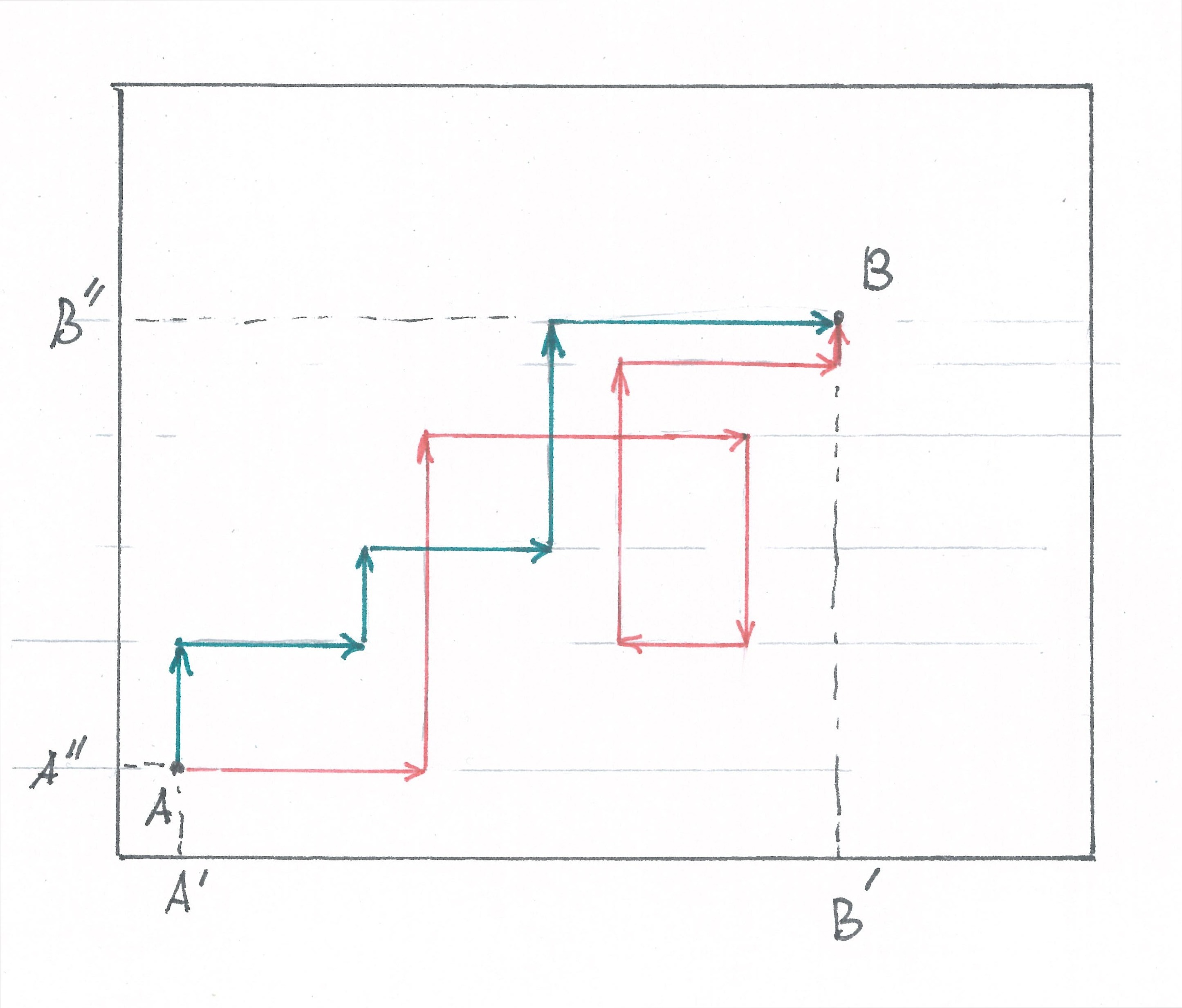
Figure 14
In that case, and only in that case, when all the horizontal segments of
Now let's address the second question. Suppose points
It can be shown, and it is nearly obvious, that the uniform distribution and independence of the selection of points
Let
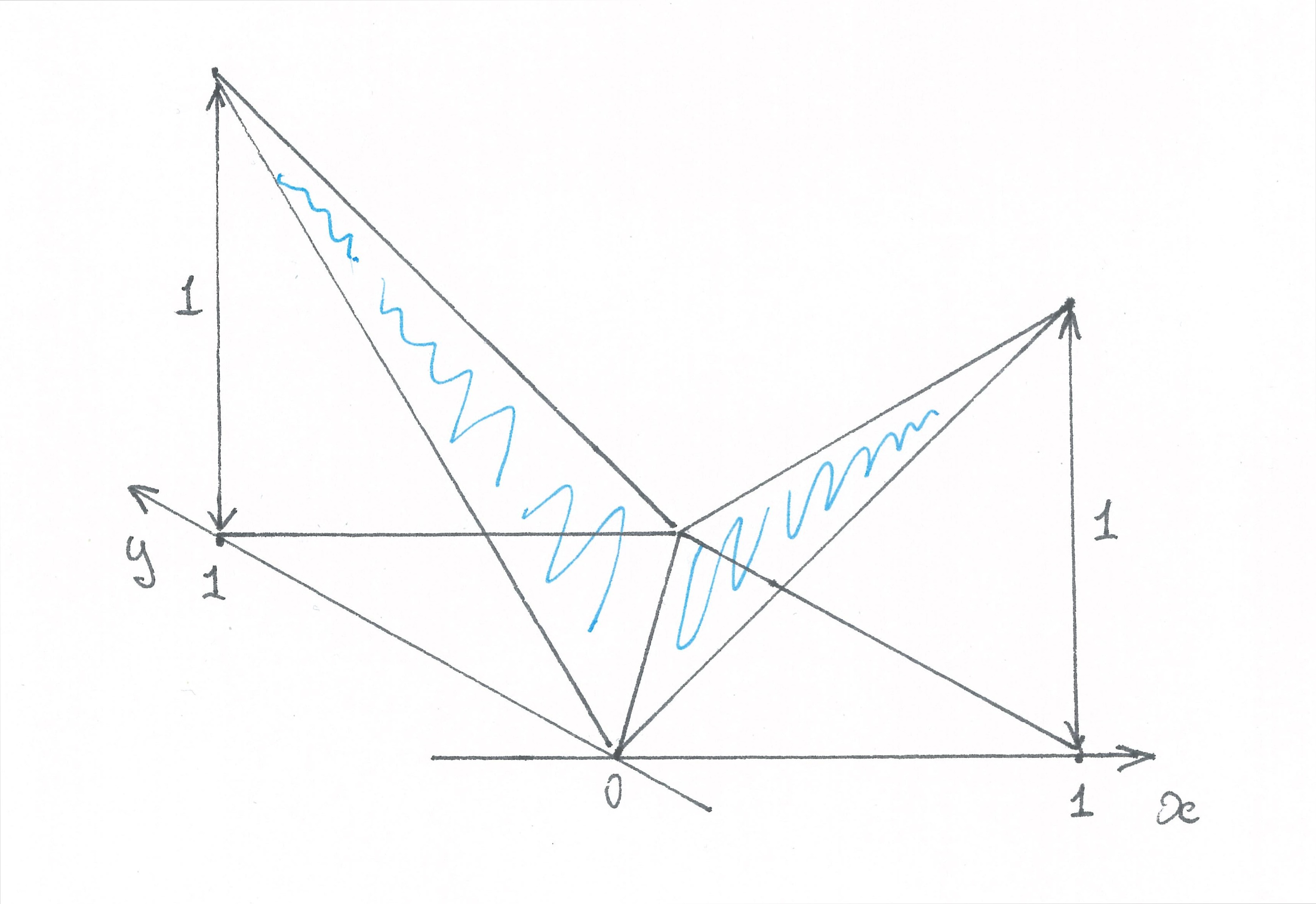
Figure 15
The distance between
Exercise: Show that in a rectangle of size
4.5 Average Duration of Inter-Cell Taxi Journeys
If all journeys in the city are made by private cars, the routes of most of them can be planned along the shortest staircase curve. In this case, the average trip length would be close to
Let's consider a traveler who needs to travel from an intersection
To estimate the average length of the middle segment, let's assume that the size of the cells into which the city is divided is much smaller than the size of the city itself, i.e.,
The average time required for a journey in the city using inter-cell taxis can be found as the «average trip length divided by the average speed, plus the average waiting time for transportation.» We estimated the average trip length as
which is
longer than the average travel time by a private car.
4.6 Average Number of Passengers in the Cabin
How many passengers does an inter-cell taxi carry at once? Let's assume that, on average, there are
passengers striving to travel.
The formula written above predictably shows that the larger the size of the cells we divide the city into and the larger the movement interval we set for the taxis circulating between these cells, the greater the number of passengers each of them will transport at once. However, we cannot make the cell size
from which:
or in the limit:
Substituting the expression for
Let's find the values of
Taking derivatives directly here would be too cumbersome, so we will use a little trick. Notice that the constraint equation consists of two terms. Let's take an arbitrary
From which we have:
Now we can optimize
subject to the condition
From the two equations above, we immediately have:
which implies
Substituting the optimal values of
4.7 Estimation for Real Cities
Let's see how
Let's assume that each city resident makes an average of
For a hypothetical New York (London, Moscow):
Population
Density
Effective diameter
Allowed speed
For a hypothetical Berlin:
Population
Density
Effective diameter
Allowed speed
For a hypothetical Paris:
Population
Density
Effective diameter
Allowed speed
For a hypothetical Prague:
Population
Density
Effective diameter
Allowed speed
4.8 Critique
The estimates we obtained above show that the idea of shared trips has theoretical validity (Uber can make it happen) and should be further explored. As for the intercellular taxi scheme, while it serves as a good starting point for research, it is not well-suited for practical implementation. The main reasons for its limited applicability can be summarized as follows:
1) Only in very large cities will there be enough fellow passengers to fill a very small bus, so intercellular taxi cannot be considered as mass transport.
2) The claim that traveling by intercellular taxi in the city takes, on average, no more than
In the following sections, we will develop non-stop public transport schemes that completely overcome problem 2) and, to a large extent, problem 1), but they will only be suitable for cities with a population above one million. Therefore, let us consider an interesting solution that can effectively operate in smaller cities.
5. Shared Taxi with One Transfer
5.1 Guiding Considerations
Let's consider a city with a square shape and a side length of approximately 10 km, populated with a density of around 5000 people per square kilometer. With these assumptions, the city would be home to approximately 500,000 people, so it cannot be considered small. The average travel distance within the city would be
If we set the permissible driving speed in this city to be
Can we somehow increase this number?
To make it easier to understand how this can be done, let's make some changes to the taxi movement regulations. Firstly, we will assume that vertical and horizontal roads pass through the center of each cell
If we observe the taxis carrying passengers from cell
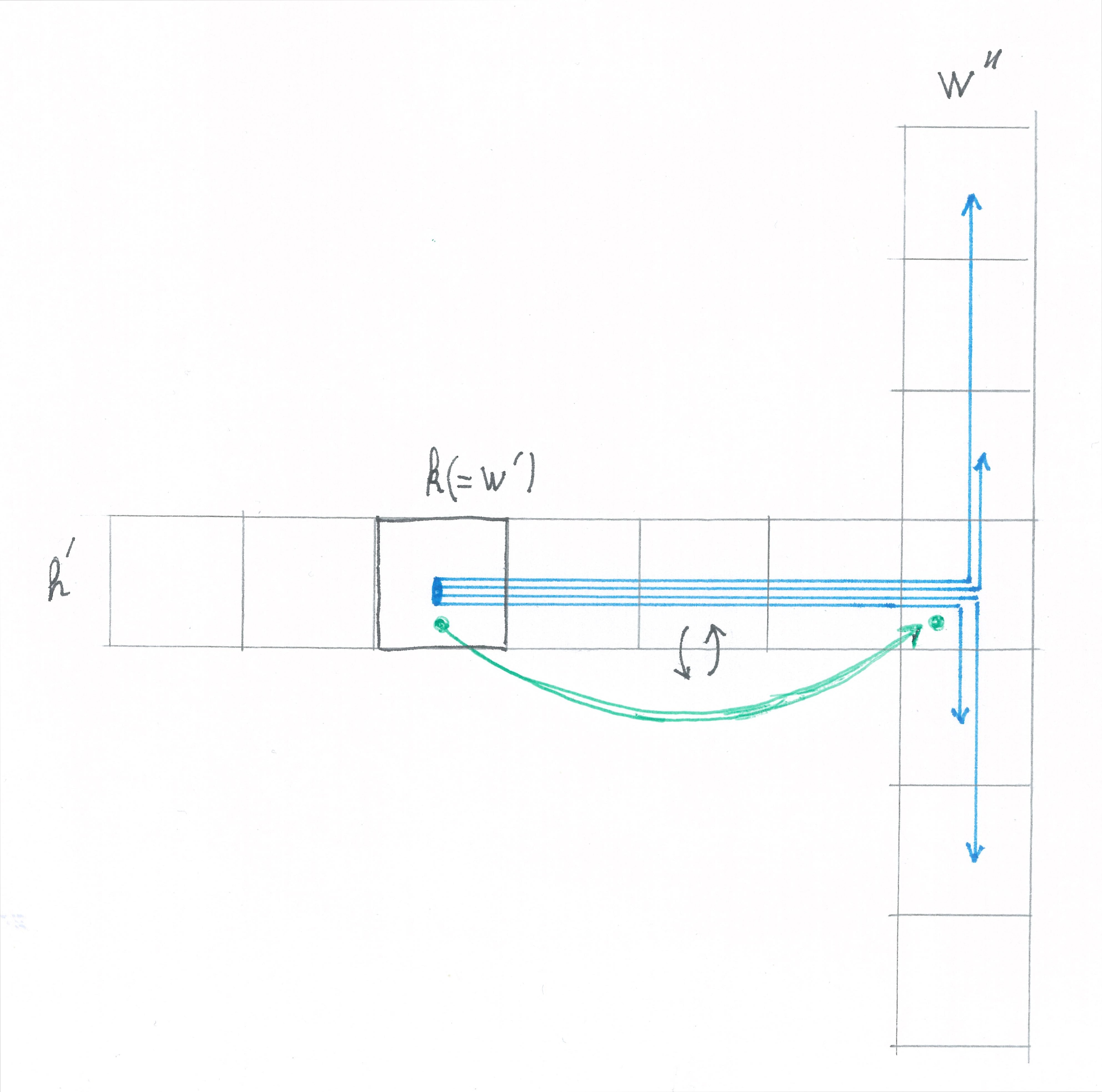
Figure 16
To make it easier to understand how this can be done, let's make some changes to the taxi movement regulations. Firstly, we will assume that vertical and horizontal roads pass through the center of each cell
If we observe the taxis carrying passengers from cell

Figure 16
5.2 Vehicle Movement Regulations
Alright, for each cell
If we extend the described rules to all rows and columns of the grid
Indeed, within such a scheme, all the shared taxi cars are distributed into two roles: some solely collect passengers from their starting positions — let's call such cars «collecting» cars, while others only deliver them to their destinations — let's call them «delivering» cars. When a collecting car reaches the transfer point, it drops off all its passengers and returns empty to its home cell. Similarly, after a delivering car has once again transported all its passengers within its home cell, it travels to the transfer point empty, ready to pick up the next passengers there.
Can we optimize the scheme so that all cars operate at full capacity? It turns out we can. To achieve this, we establish a one-to-one correspondence between the sets of cells
Thanks to the implementation of the two new rules, the shared taxi cars will always operate at full capacity. The route of each car will follow a circular pattern: from its «home» cell
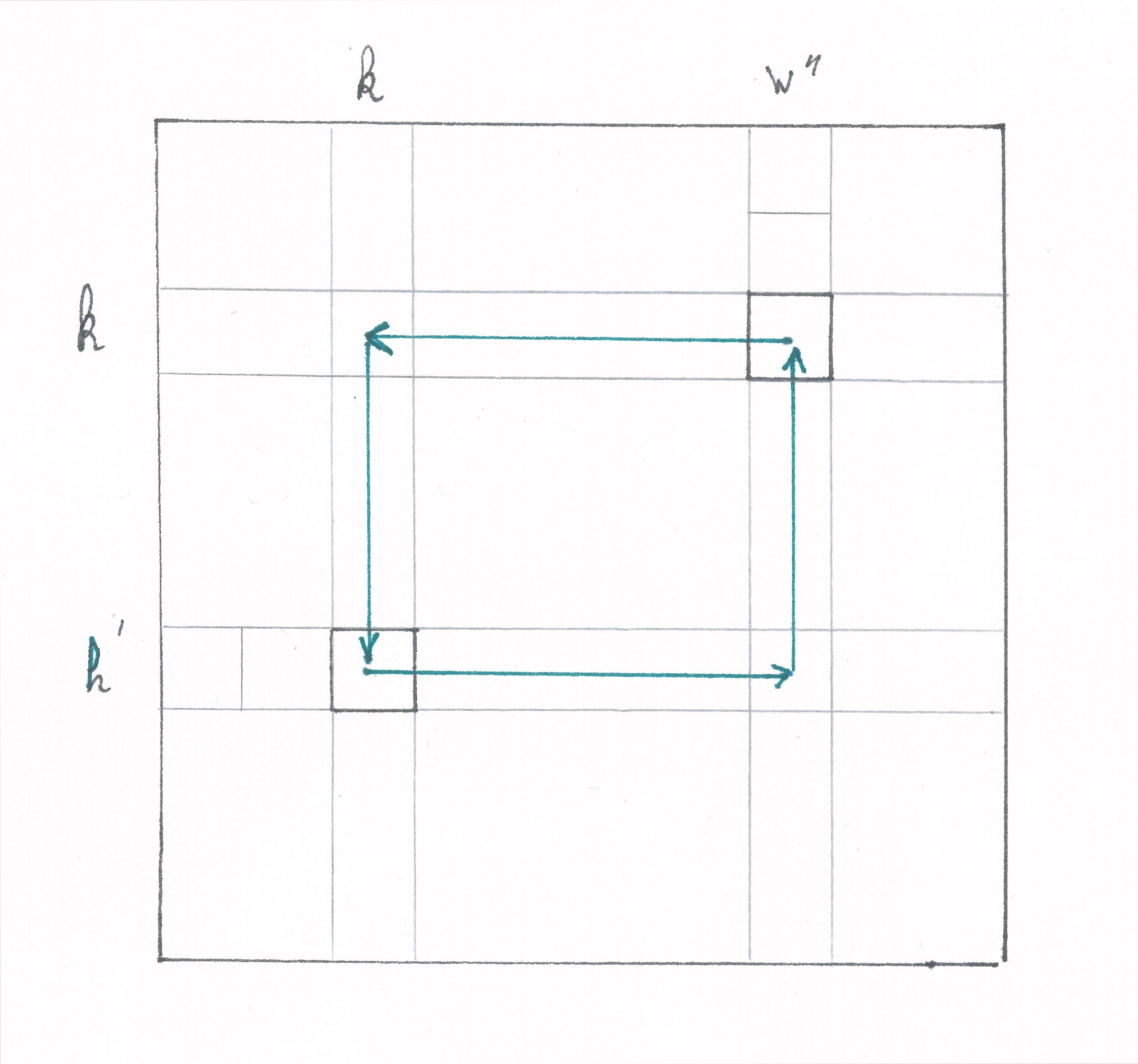
Figure 17
5.3 Travel Delay and Passenger Count
The travel routes for taxis with one transfer, excluding any additional transfers, remain almost the same as those for intercellular taxis. The average delay in traversing the snake-like sections within the starting and finishing cells remains unchanged and is given by:
However, the average time spent waiting at the stop for a suitable car has doubled (one needs to wait twice), and it is now approximately:
Now let's calculate the expected number of passengers in the car. When the car serves as a delivery vehicle between cell
If we want the travel time for taxis with one transfer to be, on average, no more than
To optimize
where
After the transformations, we have:
which implies:
and consequently:
As an approximation,
Let's see what values
For a hypothetical New York (London, Moscow):
Effective diameter
Permitted speed
For a hypothetical Berlin:
Effective diameter
Permitted speed
For a hypothetical Paris:
Effective diameter
Permitted speed
For a hypothetical Prague:
Effective diameter
Permitted speed
For a hypothetical standard half-million city:
Population
Density
Effective diameter
Permitted speed
5.5 Critique
From the above estimates, it can be seen that the average occupancy of taxis with one transfer is approximately twice as high as the average occupancy of intercellular taxis, all else being equal. But!
Like intercellular taxis, taxis with one transfer prove to be too slow for transportation if all your trips are made between closely located cells. Like intercellular taxis, the scheme of taxis with one transfer, as presented here, is not designed for practical implementation: in the following parts, we will explore more advanced implementations of this scheme.
Let's start the discussion! If you would like to discuss anything in detail, you can email me at magnolia@bk.ru.
Sergey Kovalenko,
April 2023.
Link to Part 1: «Preliminary Analysis» (ру / eng )
Link to Part 2: «Experiments on a Torus» (ру / eng )
Link to Part 3: «Practically Significant Solutions» (ру / eng )
Link to «Summary» (ру / eng )

